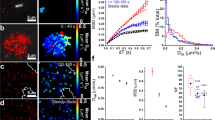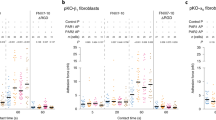Abstract
Crystal structures of the lectin and epidermal growth factor (EGF)–like domains of P-selectin show 'bent' and 'extended' conformations. An extended conformation would be 'favored' by forces exerted on a selectin bound at one end to a ligand and at the other end to a cell experiencing hydrodynamic drag forces. To determine whether the extended conformation has higher affinity for ligand, we introduced an N-glycosylation site to 'wedge open' the interface between the lectin and EGF-like domains of P-selectin. This alteration increased the affinity of P-selectin for its ligand P-selectin glycoprotein 1 (PSGL-1) and thereby the strength of P-selectin-mediated rolling adhesion. Similarly, an asparagine-to-glycine substitution in the lectin-EGF-like domain interface of L-selectin enhanced rolling adhesion under shear flow. Our results demonstrate that force, by 'favoring' an extended selectin conformation, can strengthen selectin-ligand bonds.
This is a preview of subscription content, access via your institution
Access options
Subscribe to this journal
Receive 12 print issues and online access
$209.00 per year
only $17.42 per issue
Buy this article
- Purchase on Springer Link
- Instant access to full article PDF
Prices may be subject to local taxes which are calculated during checkout







Similar content being viewed by others
References
Rosen, S.D. & Bertozzi, C.R. The selectins and their ligands. Curr. Opin. Cell Biol. 6, 663–673 (1994).
Springer, T.A. Traffic signals for lymphocyte recirculation and leukocyte emigration: the multi-step paradigm. Cell 76, 301–314 (1994).
Kansas, G.S. Selectins and their ligands: Current concepts and controversies. Blood 88, 3259–3287 (1996).
Vestweber, D. & Blanks, J.E. Mechanisms that regulate the function of the selectins and their ligands. Physiol. Rev. 79, 181–213 (1999).
Butcher, E.C. & Picker, L.J. Lymphocyte homing and homeostasis. Science 272, 60–66 (1996).
McEver, R.P. Selectins: lectins that initiate cell adhesion under flow. Curr. Opin. Cell Biol. 14, 581–586 (2002).
Lawrence, M.B. & Springer, T.A. Leukocytes roll on a selectin at physiologic flow rates: distinction from and prerequisite for adhesion through integrins. Cell 65, 859–873 (1991).
Alon, R., Hammer, D.A. & Springer, T.A. Lifetime of the P-selectin: carbohydrate bond and its response to tensile force in hydrodynamic flow. Nature 374, 539–542 (1995).
McEver, R.P. Adhesive interactions of leukocytes, platelets, and the vessel wall during hemostasis and inflammation. Thromb. Haemost. 86, 746–756 (2001).
Chen, S., Alon, R., Fuhlbrigge, R.C. & Springer, T.A. Rolling and transient tethering of leukocytes on antibodies reveal specializations of selectins. Proc. Natl. Acad. Sci. USA 94, 3172–3177 (1997).
Chen, S. & Springer, T.A. An automatic braking system that stabilizes leukocyte rolling by an increase in selectin bond number with shear. J. Cell Biol. 144, 185–200 (1999).
Ramachandran, V., Williams, M., Yago, T., Schmidtke, D.W. & McEver, R.P. Dynamic alterations of membrane tethers stabilize leukocyte rolling on P-selectin. Proc. Natl. Acad. Sci. USA 101, 13519–13524 (2004).
Yago, T. et al. Distinct molecular and cellular contributions to stabilizing selectin-mediated rolling under flow. J. Cell Biol. 158, 787–799 (2002).
de Chateau, M., Chen, S., Salas, A. & Springer, T.A. Kinetic and mechanical basis of rolling through an integrin and novel Ca2+-dependent rolling and Mg2+-dependent firm adhesion modalities for the α4β7-MAdCAM-1 interaction. Biochemistry 40, 13972–13979 (2001).
Marshall, B.T. et al. Direct observation of catch bonds involving cell-adhesion molecules. Nature 423, 190–193 (2003).
Sarangapani, K.K. et al. Low force decelerates L-selectin dissociationfrom P-selectin glycoprotein ligand-1 and endoglycan. J. Biol. Chem. 279, 2291–2298 (2003).
Yago, T. et al. Catch bonds govern adhesion through L-selectin at threshold shear. J. Cell Biol. 166, 913–923 (2004).
Springer, T.A. Traffic signals on endothelium for lymphocyte recirculation and leukocyte emigration. Annu. Rev. Physiol. 57, 827–872 (1995).
Ley, K. & Kansas, G.S. Selectins in T-cell recruitment to non-lymphoid tissues and sites of inflammation. Nat. Rev. Immunol. 4, 325–336 (2004).
Rosen, S.D. Ligands for L-selectin: homing, inflammation, and beyond. Annu. Rev. Immunol. 22, 129–156 (2004).
Foxall, C. et al. The three members of the selectin receptor family recognize a common carbohydrate epitope, the sialyl LewisX oligosaccharide. J. Cell Biol. 117, 895–902 (1992).
Sako, D. et al. Expression cloning of a functional glycoprotein ligand for P-selectin. Cell 75, 1179–1186 (1993).
Somers, W.S., Tang, J., Shaw, G.D. & Camphausen, R.T. Insights into the molecular basis of leukocyte tethering and rolling revealed by structures of P- and E-selectin bound to SLeX and PSGL-1. Cell 103, 467–479 (2000).
Konstantopoulos, K., Hanley, W.D. & Wirtz, D. Receptor-ligand binding: 'catch' bonds finally caught. Curr. Biol. 13, R611–R613 (2003).
Patel, K.D., Nollert, M.U. & McEver, R.P. P-selectin must extend a sufficient length from the plasma membrane to mediate rolling of neutrophils. J. Cell Biol. 131, 1893–1902 (1995).
Kansas, G.S., Spertini, O., Stoolman, L.M. & Tedder, T.F. Molecular mapping of functional domains of the leukocyte receptor for endothelium, LAM-1. J. Cell Biol. 114, 351–358 (1991).
Dwir, O., Kansas, G.S. & Alon, R. An activated L-selectin mutant with conserved equilibrium binding properties but enhanced ligand recognition under shear flow. J. Biol. Chem. 275, 18682–18691 (2000).
Kansas, G.S. et al. A role for the epidermal growth factor-like domain of P-selectin in ligand recognition and cell adhesion. J. Cell Biol. 124, 609–618 (1994).
Graves, B.J. et al. Insight into E-selectin/ligand interaction from the crystal structure and mutagenesis of the lec/EGF domains. Nature 367, 532–538 (1994).
von Andrian, U.H. et al. Two-step model of leukocyte-endothelial cell interaction in inflammation: Distinct roles for LECAM-1 and the leukocyte β2 integrins in vivo. Proc. Natl. Acad. Sci. USA 88, 7538–7542 (1991).
Wenzel, K., Hanke, R. & Speer, A. Polymorphism in the human E-selectin gene detected by PCR-SSCP. Hum. Genet. 94, 452–453 (1994).
Wenzel, K., Ernst, M., Rohde, K., Baumann, G. & Speer, A. DNA polymorphisms in adhesion molecule genes–a new risk factor for early atherosclerosis. Hum. Genet. 97, 15–20 (1996).
Revelle, B.M., Scott, D. & Beck, P.J. Single amino acid residues in the E- and P-selectin epidermal growth factor domains can determine carbohydrate binding specificity. J. Biol. Chem. 271, 16160–16170 (1996).
Rao, R.M., Haskard, D.O. & Landis, R.C. Enhanced recruitment of Th2 and CLA-negative lymphocytes by the S128R polymorphism of E-selectin. J. Immunol. 169, 5860–5865 (2002).
Rao, R.M. et al. The S128R polymorphism of E-selectin mediates neuraminidase-resistant tethering of myeloid cells under shear flow. Eur. J. Immunol. 32, 251–260 (2002).
Finger, E.B. et al. Adhesion through L-selectin requires a threshold hydrodynamic shear. Nature 379, 266–269 (1996).
Evans, E., Leung, A., Heinrich, V. & Zhu, C. Mechanical switching and coupling between two dissociation pathways in a P-selectin adhesion bond. Proc. Natl. Acad. Sci. USA 101, 11281–11286 (2004).
Sarangapani, K.K. et al. Low force decelerates L-selectin dissociation from P-selectin glycoprotein ligand-1 and endoglycan. J. Biol. Chem. 279, 2291–2298 (2004).
Reeves, P.J., Callewaert, N., Contreras, R. & Khorana, H.G. Structure and function in rhodopsin: high-level expression of rhodopsin with restricted and homogeneous N-glycosylation by a tetracycline-inducible N-acetylglucosaminyltransferase I-negative HEK293S stable mammalian cell line. Proc. Natl. Acad. Sci. USA 99, 13419–13424 (2002).
Mitoma, J. et al. Extended core 1 and core 2 branched O-glycans differentially modulate Sialyl Lewis x-type L-selectin ligand activity. J. Biol. Chem. 278, 9953–9961 (2003).
Geng, J-G. et al. Rapid neutrophil adhesion to activated endothelium mediated by GMP-140. Nature 343, 757–760 (1990).
Erbe, D.V. et al. P- and E- selectin use common sites for carbohydrate ligand recognition and cell adhesion. J. Cell Biol. 120, 1227–1235 (1993).
Wu, G., Xi, X., Li, P., Chu, X. & Ruan, C. Preparation of a monoclonal antibody, SZ-51, that recognizes an α-granule membrane protein (GMP-140) on the surface of activated human platelets. Nouv. Rev. Fr. Hematol. 32, 231–235 (1990).
Moore, K.L. et al. P-selectin glycoprotein ligand-1 mediates rolling of human neutrophils on P-selectin. J. Cell Biol. 128, 661–671 (1995).
Larsen, E. et al. PADGEM protein: A receptor that mediates the interaction of activated platelets with neutrophils and monocytes. Cell 59, 305–312 (1989).
Setiadi, H., Sedgewick, G., Erlandsen, S.L. & McEver, R.P. Interactions of the cytoplasmic domain of P-selectin with clathrin-coated pits enhance leukocyte adhesion under flow. J. Cell Biol. 142, 859–871 (1998).
Lu, C. & Springer, T.A. The α subunit cytoplasmic domain regulates the assembly and adhesiveness of integrin lymphocyte function-associated antigen-1 (LFA-1). J. Immunol. 159, 268–278 (1997).
Takagi, J., Erickson, H.P. & Springer, T.A. C-terminal opening mimics “inside-out” activation of integrin α5β1 . Nat. Struct. Biol. 8, 412–416 (2001).
Keefe, A.D., Wilson, D.S., Seelig, B. & Szostak, J.W. One-step purification of recombinant proteins using a nanomolar-affinity streptavidin-binding peptide, the SBP-Tag. Protein Expr. Purif. 23, 440–446 (2001).
Chen, S. & Springer, T.A. Selectin receptor-ligand bonds: Formation limited by shear rate and dissociation governed by the Bell model. Proc. Natl. Acad. Sci. USA 98, 950–955 (2001).
Acknowledgements
We thank R. Camphausen for suggestions and discussion. Supported by Kirschstein National Research Service Award (F32 AI052851 to U.T.P., F32 GM073529 to T.T.W. and HL-48675 to T.A.S).
Author information
Authors and Affiliations
Corresponding author
Ethics declarations
Competing interests
The authors declare no competing financial interests.
Supplementary information
Supplementary Table 1
Primers were used in PCR-based mutagenesis to generate the various P-selectin and L-selectin variants. (PDF 49 kb)
Rights and permissions
About this article
Cite this article
Phan, U., Waldron, T. & Springer, T. Remodeling of the lectin–EGF-like domain interface in P- and L-selectin increases adhesiveness and shear resistance under hydrodynamic force. Nat Immunol 7, 883–889 (2006). https://doi.org/10.1038/ni1366
Received:
Accepted:
Published:
Issue Date:
DOI: https://doi.org/10.1038/ni1366
This article is cited by
-
Sphingosine 1-phosphate modulation and immune cell trafficking in inflammatory bowel disease
Nature Reviews Gastroenterology & Hepatology (2022)
-
Genome-scale Solanum spp.-Ralstonia solanacearum interactome reveals candidate determinants for host specificity and environmental adaptation
European Journal of Plant Pathology (2022)
-
Stabilization of the Hinge Region of Human E-selectin Enhances Binding Affinity to Ligands Under Force
Cellular and Molecular Bioengineering (2021)
-
Comparison of human and mouse E-selectin binding to Sialyl-Lewisx
BMC Structural Biology (2016)
-
Mechanochemitry: A Molecular Biomechanics View of Mechanosensing
Annals of Biomedical Engineering (2014)



